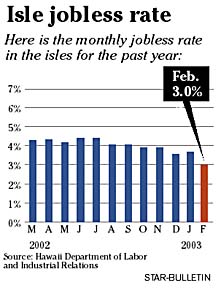
Unemployment Hawaii's unemployment rate dropped to 3.0 percent from 3.7 percent in January, the lowest figure recorded since the early 1990s, according to the state Department of Labor and Industrial Relations.
in Hawaii
dives to 3%
The jobless rate is
the lowest since 1991By Lyn Danninger
ldanninger@starbulletin.comFebruary was the fifth consecutive month that unemployment was below 4 percent. A year earlier, the state unemployment rate stood at 4.7 percent.
"Since 1994, this would be the lowest it's been and that year they changed the way unemployment is computed," said James Hardway, assistant to the director of the state Department of Labor and Industrial Relations. "But if you look back at records even older than that, you'd have to go back to 1991 when it was below 3 percent for almost all of the year."
There was little change in unemployment at the national level, which fell to 6.4 percent in February from 6.5 percent in January. In February 2002, the national unemployment rate stood at 6.1 percent.
A total of 576,400 people were employed in the state in February while 17,700 people were out of work. Total non-agricultural payroll jobs in Hawaii increased by 3,900 in February for a total count of 564,650 jobs. In February 2002, there were 549,200 non-agricultural payroll jobs.
Seasonal factors accounted for most of the job gains, the labor department said.
State government added 2,900 jobs, mostly in the education with the beginning of the spring semester. Private schools and colleges added 1,000 more jobs.
Apart from the education sector, two other areas accounted for the rise of employment during February. The health care and social assistance sector grew by 600 jobs, while construction added 400 jobs.
Job losses were seen in a few areas, notably in retail, which trimmed 900 seasonal holiday jobs. With the return of striking nurses at three Oahu hospitals, 400 temporary jobs, mostly filled by health care workers from employment agencies, were also trimmed. The information sector, which includes publishing, motion pictures, sound recording and telecommunications, shed 200 jobs.
Nelson Befitel, director of the labor department, described Hawaii's unemployment picture as "encouraging" when compared to the national unemployment rate. Noting that the state has yet to feel any significant impact on unemployment since the war in Iraq began, Befitel said he was "cautiously optimistic" that Hawaii's economy has stabilized to the point that any impact on jobs would be minimized.
Hawaii Pacific University economics professor Leroy Laney said it's difficult to account for Hawaii's continuing job growth considering the softening mainland economy and the uncertainty of world events.
"It's a remarkable number and a surprisingly high number, but beyond that I'm really at a loss to explain it. Whether it can be sustained, we'll just have to wait and see," he said.
During the 1991 Gulf War, Hawaii lost 4,300 jobs, mostly tourism-related.
Dept. of Labor and Industrial Relations
